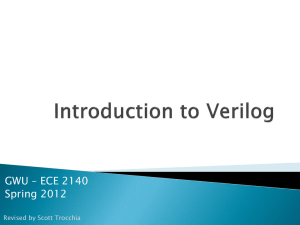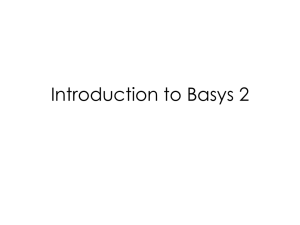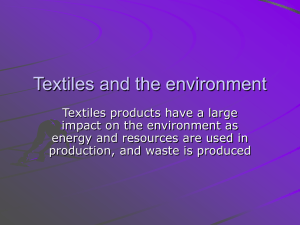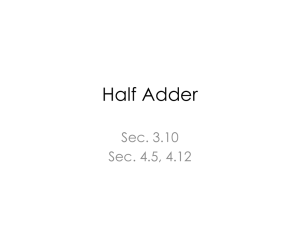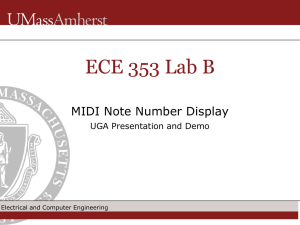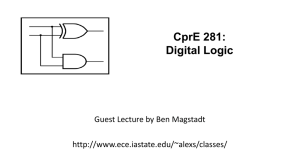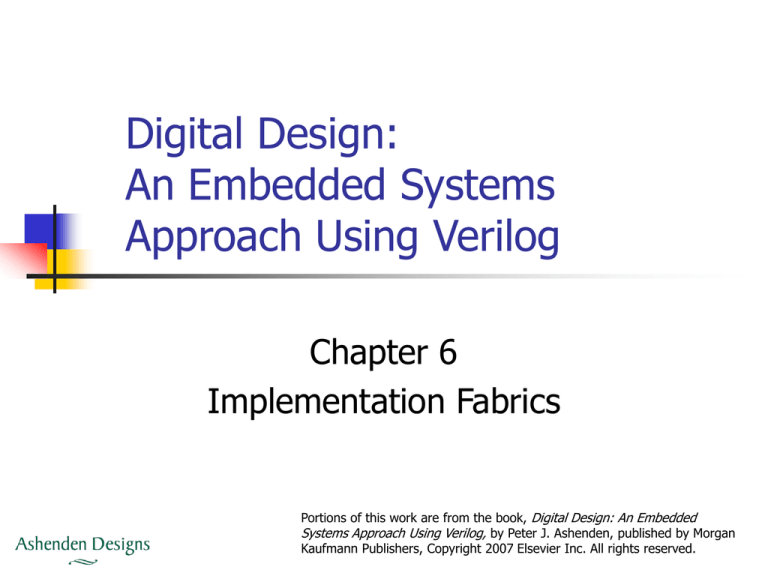
Digital Design:
An Embedded Systems
Approach Using Verilog
Chapter 6
Implementation Fabrics
Portions of this work are from the book, Digital Design: An Embedded
Systems Approach Using Verilog, by Peter J. Ashenden, published by Morgan
Kaufmann Publishers, Copyright 2007 Elsevier Inc. All rights reserved.
Verilog
Integrated Circuits
Early digital circuits
Relays, vacuum tubes, discrete transistors
Integrated circuits (ICs, or “chips”)
Manufacture of multiple transistors and
connections on surface of silicon wafer
Invented in 1958: Jack Kilby at Texas
Instruments (TI)
Rapid growth since then, and ongoing
Digital Design — Chapter 6 — Implementation Fabrics
2
Verilog
IC Manufacture: Wafers
Start with ingot of
pure silicon
Saw into wafers &
polish
Early wafers:
50mm
Now 300mm
Digital Design — Chapter 6 — Implementation Fabrics
3
Verilog
IC manufacture: Processing
Chemical processing steps based on
photolithography
Ion implantation
Etching a deposited film
SiO2, polysilicon, metal
resist
film
wafer
mask
(a)
(b)
(c)
(d)
(e)
Digital Design — Chapter 6 — Implementation Fabrics
4
Verilog
IC Manufacture: Test & Packaging
Defects cause some ICs to fail
Test to identify which ICs don’t work
Discard them when wafer is broken into
chips
Yield depends (in part) on IC area
Their cost is amortized over working chips
Constrain area to reduce final IC cost
Working chips are packaged and tested
further
Digital Design — Chapter 6 — Implementation Fabrics
5
Verilog
Exponential Trends
Circuit size and complexity depends on
minimum feature size
Which depends on manufacturing process
Mask resolution, wavelength of light
Process nodes (ITRS Roadmap)
350nm (1995), 250nm (1998),
180nm (2000), 130nm (2002),
90nm (2004), 65nm (2007), 45nm (2010),
32nm (2013), 22nm (2016), 16nm (2019)
Smaller feature size denser, faster
Digital Design — Chapter 6 — Implementation Fabrics
6
Verilog
SSI and MSI
In 1964, TI introduced 5400/7400
family of TTL ICs
Other manufacturers followed, making
7400 family a de facto standard
Small-scale integrated (SSI)
7400: 4 × NAND gate
7474: 2 × D flip-flop
7427: 4 × NOR gate
…
Medium-scale integrated (MSI)
7490: 4-bit counter
…
7494: 4-bit shift reg
Digital Design — Chapter 6 — Implementation Fabrics
7
Verilog
Other Logic Families
Variations on electrical characteristics
74L… : low power
74S… : Schottky diodes fast switching
74LS… : compromise between speed and
power
74ALS… : advances low-power Schottky
74F… : fast
CMOS families
4000 family: very low power, 3–15V
74HC…, 74AHC… : TTL compatible
Digital Design — Chapter 6 — Implementation Fabrics
8
Verilog
Large Scale Integration
1970s: LSI (thousands of transistors)
Small microprocessors became feasible
Custom LSI chips for high-volume
applications
SSI/MSI mainly used for glue logic
Later additions to 74xx… families
oriented toward glue-logic and
interfacing
E.g., multibit tristate drivers, registers
Other functions supplanted by PLDs
Digital Design — Chapter 6 — Implementation Fabrics
9
Verilog
MSI Example: Counter/Display
74LS390: dual decade counter
CP0 Q0
CP1 Q1
Q2
MR Q3
74LS08 glue
CP0 Q0
CP1 Q1
Q2
MR Q3
CP0 Q0
CP1 Q1
Q2
MR Q3
CP0 Q0
CP1 Q1
Q2
MR Q3
CP0 Q0
CP1 Q1
Q2
MR Q3
74LS47: 7-segment decoder
Digital Design — Chapter 6 — Implementation Fabrics
A
B
C
D
a
b
c
d
e
f
LT
g
RBI RBO
10
Verilog
MSI Example: Counter/Display
+V
CP
CP0 Q0
CP1 Q1
Q2
MR Q3
A
B
C
D
a
b
c
d
e
+V
f
LT
g
RBI RBO
+V
CP0 Q0
CP1 Q1
Q2
MR Q3
A
B
C
D
a
b
c
d
e
+V
f
LT
g
RBI RBO
+V
CP0 Q0
CP1 Q1
Q2
MR Q3
A
B
C
D
a
b
c
d
e
+V
f
LT
g
RBI RBO
+V
MR
CP0 Q0
CP1 Q1
Q2
MR Q3
A
B
C
D
a
b
c
d
e
+V
f
LT
g
RBI RBO
Digital Design — Chapter 6 — Implementation Fabrics
11
Verilog
VLSI and ASICs
1980s: Very Large Scale Integration
Then ULSI, then what?
VLSI now just means IC design
Application-specific ICs (ASICs)
Enabled by CAD tools, foundry services
Often designed for a range of related
products in a market segment
Application-specific standard products (ASSPs)
E.g., cell phone ICs
Digital Design — Chapter 6 — Implementation Fabrics
12
Verilog
ASIC Economics
ASIC has lower unit cost than an FPGA
But more design/verification effort
Higher non-recurring engineering (NRE) cost
ASICs make sense for high volumes
Full custom
Amortized over production run
Design each transistor and wire
High NRE, but best performance & least area
Standard cell
Use basic components from a foundry’s library
Digital Design — Chapter 6 — Implementation Fabrics
13
Verilog
Programmable Logic Devices (PLDs)
PLDs can be programmed after
manufacture to vary their function
C.f. fixed-function SSI/MSI ICs and ASICs
Higher unit cost than ASIC
But lower NRE
Ideal for low to medium product volumes
Digital Design — Chapter 6 — Implementation Fabrics
14
Verilog
Programmable Array Logic (PALs)
Introduced by Monolithic Memories Inc
in 1970s
First widely-used PLDs
Programmed by blowing fusible links in the
circuit
PAL16L8
Use a special programming instrument
16 inputs, 8 active-low outputs
PAL16R8
16 inputs, 8 registered outputs
Digital Design — Chapter 6 — Implementation Fabrics
15
Verilog
PAL16L8
I8 · I10
I1 · I2 + I3 · I10
Digital Design — Chapter 6 — Implementation Fabrics
16
Verilog
PAL16R8 Output Circuit
Feedback path is useful for
implementing FSMs
Digital Design — Chapter 6 — Implementation Fabrics
17
Verilog
Designing with PALs
Useful even for simple circuits
Single package solution lowers cost
Describe function using Boolean
equations
In HDL, or simple language such as ABEL
Synthesize to fuse map file used by
programming instrument
If design doesn’t fit
Partition into multiple PALs or use a more
complex PLD
Digital Design — Chapter 6 — Implementation Fabrics
18
Verilog
Generic Array Logic (GALs)
Programmable Output
Logic Macrocells
(OLMCs)
Use EEPROM technology
E.g., GAL22V10
Digital Design — Chapter 6 — Implementation Fabrics
19
Verilog
Complex PLDs (CPLDs)
Cramming multiple PALs into an IC
Programmable interconnection network
Use flash RAM technology to store configuration
Embedded
PAL
Digital Design — Chapter 6 — Implementation Fabrics
20
Verilog
FPGAs
Field Programmable Gate Arrays
Smaller logic blocks, embedded SRAM
Thousands or millions of equivalent gates
…
IO
IO
IO
IO
IO …
… IO
IO
LB
LB
LB
LB …
… LB
LB
IO
… LB
LB
IO
… LB
LB
IO
… LB
LB
IO
IO
LB
LB
LB
LB …
IO
LB
LB
LB
LB …
IO
LB
LB
LB
LB
LB …
IO
IO
IO
IO …
…
… LB
LB
IO
… LB
LB
IO
… IO
…
IO
…
LB
RAM
…
LB …
…
LB
RAM
…
LB
RAM
…
…
LB
LB …
…
…
IO
LB
…
…
…
IO
…
Programmable
interconnect
Digital Design — Chapter 6 — Implementation Fabrics
21
Verilog
Logic Block Example
Xilinx FPGA Logic Blocks
Lookup Tables (LUTs) plus flip-flops
E.g., Spartan-II
Too complex to
program LBs
manually
Let synthesis tools
map HDL code to
LBs and program
the interconnect
G4
G3
G2
G1
LUT
I4
O
I3
I2
I1
Carry
and
Control
Logic
LUT
I4
O
I3
I2
I1
Carry
and
Control
Logic
COUT
YB
Y
S
D
Q
CE
clk
R
YQ
F5IN
BY
SR
F4
F3
F2
F1
XB
X
S
D
Q
CE
clk
R
XQ
BX
CIN
CE
CLK
Digital Design — Chapter 6 — Implementation Fabrics
22
Verilog
I/O Blocks
Typically allow for
registered or
combinational
input/output, plus
tristates
Programmable logic
levels, slew rate,
input threshold, …
0
D
Q
1
CE
+V
clk
0
D
Q
1
CE
clk
D
Q
CE
clk
Digital Design — Chapter 6 — Implementation Fabrics
23
Verilog
Platform FPGAs
Include embedded cores for special
applications
Processor cores
Signal processing arithmetic cores
Network interface cores
Embedded software can run from SRAM
in the FPGA
Single-chip solution, reduces cost
Avoids high NRE of ASIC
Digital Design — Chapter 6 — Implementation Fabrics
24
Verilog
Structured ASICs
Array of very simple logic elements
Customized by designing top metal
interconnection layer(s)
Not programmable, no programmable
interconnect
Lower NRE than full ASIC design
Performance close to full ASIC
May become popular for mid-volume
applications
Digital Design — Chapter 6 — Implementation Fabrics
25
Verilog
IC Packages
ICs are encapsulated in protective
packages
External pins for connected to circuit board
Bond-wires or flip-chip connections
Digital Design — Chapter 6 — Implementation Fabrics
26
Verilog
Printed Circuit Boards (PCBs)
Layers of conducting wires (copper)
between insulating material (fiberglass)
Manufactured using photolithography and
etching
Wires interconnect ICs and other
components
External connections to other system
components
Digital Design — Chapter 6 — Implementation Fabrics
27
Verilog
Through-Hole PCBs
IC package pins pass through drilled
holes
Soldered to PCB wires that join the hole
Digital Design — Chapter 6 — Implementation Fabrics
28
Verilog
Surface Mount PCB
IC package pins soldered to wires on
PCB surface
Packages and PCB features are generally
smaller than through-hole
Digital Design — Chapter 6 — Implementation Fabrics
29
Verilog
Multichip Modules (MCMs)
Several ICs on a ceramic carrier
Can also include thin-film passives and
discrete components
External connections for PCB mounting
Ideal for high-density
applications
E.g., cell phones
Digital Design — Chapter 6 — Implementation Fabrics
30
Verilog
Signal Integrity
Signals propagate over bond wires,
package pins, PCB traces
Propagation delay in PCB trace
Various effects cause distortion and noise
Signal integrity: minimizing these effects
≈½c ≈150mm/ns
If two traces differ in length
Skew at arrival point can be significant
Careful PCB design needed
Digital Design — Chapter 6 — Implementation Fabrics
31
Verilog
Ground Bounce
Transient current flows when an output
switches logic level
Parasitic inductance causes
voltage shift on power supply
& ground signals
Spikes on other
drivers
Threshold shift on
receivers
Digital Design — Chapter 6 — Implementation Fabrics
32
Verilog
Minimizing Bounce
Bypass capacitors between ground and +V
0.01µF – 0.1µF, close to package pins
Separate PCB planes for ground and +V
Limit output slew rate
Trade off against
propagation delay
signal layer
power plane
signal layers
ground plane
signal layer
Digital Design — Chapter 6 — Implementation Fabrics
33
Verilog
Transmission Line Effects
Occur when rise time is comparable to path delay
Reflections interfere with transitions, resulting in
under/overshoot and ringing
Can cause false/multiple switching
Use PCB layout
techniques to
minimize effects
Digital Design — Chapter 6 — Implementation Fabrics
34
Verilog
Electromagnetic Interference
Transitions cause electromagnetic fields
Energy radiated from PCB traces
Induces noise in other systems
Subject to regulation
Crosstalk
Radiation to other traces in the system
Particularly adjacent parallel traces
PCB layout and slew-rate limiting can
minimize both
Digital Design — Chapter 6 — Implementation Fabrics
35
Verilog
Differential Signaling
Reduces susceptibility to noise
Transmit a signal (SP) and negation (SN)
At receiver, sense difference between them
SP – SN
Noise induced on both SP and SN
(SP + VNoise) – (SN + VNoise) = SP – SN
S
SP
SN
Digital Design — Chapter 6 — Implementation Fabrics
36
Verilog
Summary
Exponential improvements in IC
manufacturing
SSI and MSI TTL logic families
ASICs: full-custom and standard cell
PALs, CPLDs, FPGAs, platform FPGAs
IC packages for PCB assembly
Through-hole and surface mount
Signal integrity
Digital Design — Chapter 6 — Implementation Fabrics
37



